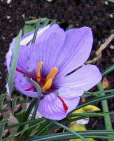 Native to an unknown place in the Mediterranean region, this cormous perennial belongs to the iris family, Iridaceae, that also includes gladiolus, crocosmia, and blue-eyed grass. It is sometimes called autumn crocus but that name is also used for a species of colchicum that is similar in appearance but poisonous. The plants grow up to 1′ tall and have basal linear grass-like leaves and fragrant, lavender, white, or purple cup-like flowers in the fall for 2-3 weeks, opening during the day and closing at night. The flowers are 1.5-2″ across and have 3 long style branches each with a reddish-orange stigmas that may protrude beyond the petal cup.
Native to an unknown place in the Mediterranean region, this cormous perennial belongs to the iris family, Iridaceae, that also includes gladiolus, crocosmia, and blue-eyed grass. It is sometimes called autumn crocus but that name is also used for a species of colchicum that is similar in appearance but poisonous. The plants grow up to 1′ tall and have basal linear grass-like leaves and fragrant, lavender, white, or purple cup-like flowers in the fall for 2-3 weeks, opening during the day and closing at night. The flowers are 1.5-2″ across and have 3 long style branches each with a reddish-orange stigmas that may protrude beyond the petal cup.
The stigmas of this crocus have been used as a spice, dye, or medicine for at least 3,500 years.
Song of Songs 4.14 (NIV) The bridegroom describes the garden of his beloved .
“ nard and saffron, calamus and cinnamon, with every kind of incense tree, with myrrh and aloes and all the finest spices.”
Saffron crocus likes full sun or bright light and moderately rich, light, well-drained soil in USDA Hardiness zones 6-8. Propagation is by division of cormlets. Plants are susceptible to damage by nematodes, leaf rust, and corm rot. Since 75,000 plants are needed to produce a pound of saffron, the plants are usually grown in the garden strickly for their ornamental value.
The genus name, Crocus, is from the Greek word κρόκος, krokos meaning thread and refers to the appearance of the stigmas.. The specific epithet, sativus, is the classical Latin word meaning sown and refers to the fact that the plant is cultivated.